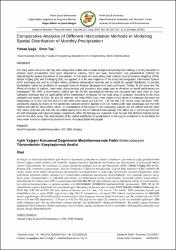| dc.contributor.author | İçağa, Yılmaz | |
| dc.contributor.author | Taş, Emin | |
| dc.date.accessioned | 2019-12-05T10:49:54Z | |
| dc.date.available | 2019-12-05T10:49:54Z | |
| dc.date.issued | May 2018 | en_US |
| dc.identifier.uri | https://hdl.handle.net/11630/7363 | |
| dc.description.abstract | For many water resources planning and management studies such as water budget and hydrological modeling, it is very important to estimate areal precipitation from point observation stations. There are many deterministic and geostatistical methods for determining the spatial distribution of precipitation. In this study, the most widely used methods, inverse distance weighting (IDW), Simple Kriging (SK) and Co-Kriging (CK) are applied. It is the main objective of the study that Geographic Information Systems (GIS) techniques are used to compare widely preferred interpolation methods and to model the spatial distribution of monthly precipitation values for prediction in ungauged areas in Akarcay Sinanpasa and Suhut sub-basins, Turkey. At the same time, the effects of number of stations, basin area, characteristics and secondary data usage such as elevation on model performance are investigated. The IDW, a deterministic method and the SK-CK, geostatistical methods are compared with each other by cross validation technique and the applicability of the interpolation techniques for the study areas is analyzed. According to the cross validation test results of IDW, SK and CK methods, the mean RMSE (root mean square error) values of Sinanpasa sub-basin are respectively 13,76 mm, 9,32 mm and 8,72 mm while these values are 9,43 mm, 7,82 mm and 7,90 mm for Suhut sub-basin. Then, uncertainty analysis by means of PSE (prediction standard error) is applied to SK-CK methods with clear advantages over the IDW method and with the close RMSE values. In consideration of the results of the uncertainty analysis, the SK method with the mean PSE values 10,30 mm and 8,54 mm has a little superiority to the CK method whose average PSE values are 11,03 mm and 9,02 mm for both Sinanpasa and Suhut sub-basins, respectively. When the findings are evaluated, it can be seen that all three methods can be used for the study areas. The determination of the spatial distribution of precipitation in this way is considered to be beneficial for many water resources engineering studies in areas of ungauged/sparsely gauged. | en_US |
| dc.description.abstract | Su bütçesi ve hidrolojik modelleme gibi birçok su kaynakları planlama ve yönetim çalışmaları için noktasal yağış gözlemlerinden
alansal yağışın tahmin edilmesi çok önemlidir. Yağışın konumsal dağılımının belirlenmesi için deterministik ve jeoistatistik birçok
yöntem bulunmaktadır. Bu çalışmada en yaygın kullanılan uzaklığın tersi ile ağırlıklandırma (IDW), Simple Kriging (SK) ve CoKriging (CK) yöntemleri uygulanmıştır. Akarçay Sinanpaşa ve Şuhut alt havzalarında, Coğrafi Bilgi Sistemleri (CBS) teknikleri ile
yaygın olarak tercih edilen enterpolasyon yöntemlerinin karşılaştırılması ve aylık yağış değerlerinin konumsal dağılımının ölçüm
yapılmayan alanlarda tahmin yapılması için modellenmesi çalışmanın ana amacını oluşturmaktadır. Aynı zamanda istasyon sayısı,
havza alanı, karakteristikleri ve yükseklik gibi ikincil veri kullanımının model performansları üzerindeki etkileri araştırılmıştır.
Deterministik bir yöntem olan IDW ve jeoistatistik yöntemler olan SK-CK yöntemlerinin çapraz doğrulama tekniği ile performansları
test edilerek karşılaştırılmış ve çalışma alanları için enterpolasyon tekniklerinin kullanılabilirliği incelenmiştir. IDW, SK ve CK
yöntemlerinin çapraz doğrulama test sonuçlarına göre Sinanpaşa alt havzası için sırasıyla RMSE (karesel ortalama hata) değerleri
13,76 mm, 9,32 mm ve 8,72 mm iken; Şuhut alt havzası için 9,43 mm, 7,82 mm ve 7,90 mm'dir. IDW yöntemine kıyasla açık
üstünlükleri olan ve yakın RMSE değerlerine sahip SK-CK yöntemlerine, ek olarak PSE (tahmin standart hatası) ile belirsizlik
analizi uygulanmıştır. Belirsizlik analizi sonuçlarına göre hem Sinanpaşa hem de Şuhut alt havzaları için SK yöntemi sırasıyla 10,30
mm ve 8,54 mm PSE değerleriyle, 11,03 mm ve 9,02 mm PSE değerlerine sahip CK yöntemine az da olsa üstünlük sağlamıştır. Elde
edilen bulgulara göre her üç yönteminde çalışma alanları için kullanılabilir olduğu görülmektedir. Bu şekilde yağışın konumsal
dağılımının belirlenmesinin ölçüm yapılmayan veya kıt ölçüm yapılan alanlarda birçok su kaynakları mühendisliği çalışmaları için
faydalı olacağı düşünülmektedir. | en_US |
| dc.language.iso | eng | en_US |
| dc.identifier.doi | 10.21324/dacd.387061 | en_US |
| dc.rights | info:eu-repo/semantics/openAccess | en_US |
| dc.subject | Areal Precipitation | en_US |
| dc.subject | Spatial Interpolation | en_US |
| dc.subject | GIS | en_US |
| dc.subject | IDW | en_US |
| dc.subject | Kriging | en_US |
| dc.title | Comparative analysis of different interpolation methods in modeling spatial distribution of monthly precipitation | en_US |
| dc.title.alternative | Aylık yağışın konumsal dağılımının modellenmesinde farklı enterpolasyon yöntemlerinin karşılaştırmalı analizi | en_US |
| dc.type | article | en_US |
| dc.relation.journal | Journal of Natural Hazards and Environment | en_US |
| dc.department | Mühendislik Fakültesi | en_US |
| dc.authorid | 0000-0002-2428-1973 | en_US |
| dc.identifier.volume | 4 | en_US |
| dc.identifier.startpage | 89 | en_US |
| dc.identifier.endpage | 104 | en_US |
| dc.identifier.issue | 2 | en_US |
| dc.relation.publicationcategory | Makale - Ulusal Hakemli Dergi - Kurum Öğretim Elemanı | en_US |
| dc.contributor.institutionauthor | İçağa, Yılmaz | |
| dc.contributor.institutionauthor | Taş, Emin | |



















